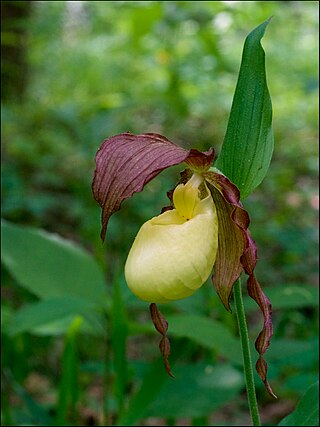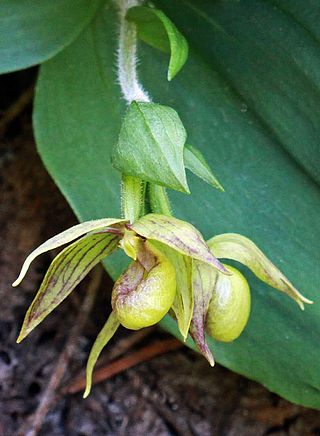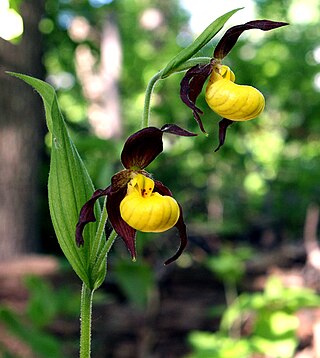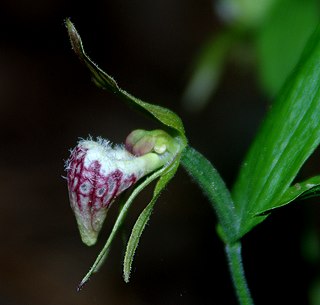
Cypripedioideae is a subfamily of orchids commonly known as lady's slipper orchids, lady slipper orchids or slipper orchids. Cypripedioideae includes the genera Cypripedium, Mexipedium, Paphiopedilum, Phragmipedium and Selenipedium. They are characterised by the slipper-shaped pouches of the flowers – the pouch traps insects so they are forced to climb up past the staminode, behind which they collect or deposit pollinia, thus fertilizing the flower. There are approximately 165 species in the subfamily.

Cypripedium is a genus of 58 species and nothospecies of hardy orchids; it is one of five genera that together compose the subfamily of lady's slipper orchids (Cypripedioideae). They are widespread across much of the Northern Hemisphere, including most of Europe and Africa (Algeria), Russia, China, Central Asia, Canada the United States, Mexico, and Central America. They are most commonly known as slipper orchids, lady's slipper orchids, or ladyslippers; other common names include moccasin flower, camel's foot, squirrel foot, steeple cap, Venus' shoes, and whippoorwill shoe. An abbreviation used in trade journals is "Cyp." The genus name is derived from Ancient Greek Κύπρις (Kúpris), an early reference in Greek myth to Aphrodite, and πέδιλον (pédilon), meaning "sandal".

Paphiopedilum, often called the Venus slipper, is a genus of the lady slipper orchid subfamily Cypripedioideae of the flowering plant family Orchidaceae. The genus comprises some 80 accepted taxa including several natural hybrids. The genus is native to Southeast Asia, the Indian Subcontinent, southern China, New Guinea and the Solomon and Bismarck Islands. The type species of this genus is Paphiopedilum insigne.

Calypso is a genus of orchids containing one species, Calypso bulbosa, known as the calypso orchid, fairy slipper or Venus's slipper. It is a perennial member of the orchid family found in undisturbed northern and montane forests. It has a small pink, purple, pinkish-purple, or red flower accented with a white lip, darker purple spottings, and yellow beard. The genus Calypso takes its name from the Greek signifying concealment, as they tend to favor sheltered areas on conifer forest floors. The specific epithet, bulbosa, refers to the bulb-like corms.

Selenipedium is a genus of the orchid family (Orchidaceae). The genus has been given its own tribe, Selenipedieae, and subtribe, Selenipediinae. It is abbreviated Sel in trade journals.

Cypripedium kentuckiense, the Kentucky lady's slipper or southern lady's slipper, is a member of the orchid genus Cypripedium. Members of this genus are commonly referred to as lady's slipper orchids.

Cypripedium acaule is a species of flowering plant in the orchid family Orchidaceae native to eastern North America. It is currently the provincial flower of Prince Edward Island, Canada, and the state wildflower of New Hampshire, United States.

Cypripedium californicum, the California lady's slipper, is a member of the orchid genus Cypripedium, the lady's slipper orchids, native to the western United States.

Cypripedium montanum is a member of the orchid genus Cypripedium. It is commonly known as large lady's slipper, mountain lady's slipper, white lady's slipper as well as moccasin flower. This latter is also the common name of Cypripedium acaule.

Cypripedium fasciculatum, the clustered lady's slipper, is a member of the orchid genus Cypripedium. Members of this genus are commonly referred to as ladies' slippers. C. fasciculatum, along with C. montanum and C. californicum, are the only members of the genus Cypripedium that are endemic to western North America.

The genus Arachnis, abbreviated as Arach in horticultural trade, is a member of the orchid family (Orchidaceae), consisting of more than 20 species native to China, India, Southeast Asia, Indonesia, the Philippines, New Guinea, and the Solomon Islands.

Cypripedium parviflorum, commonly known as yellow lady's slipper or moccasin flower, is a lady's slipper orchid native to North America. It is widespread, ranging from Alaska south to Arizona and Georgia. It grows in fens, wetlands, shorelines, and damp woodlands.

The Formosan lady's slipper or beautiful cypripedium, Cypripedium formosanum, is a species of orchid endemic to Taiwan.

Cypripedium guttatum, the spotted lady's slipper or Alaskan lady's slipper, is a species of orchid found on three continents. Each stem has about two clasping leaves that alternate. The plant has a height of 12 centimeters to 35 centimeters. The magenta and white colored labellum is pitcher shaped.

Cypripedium reginae, known as the showy lady's slipper, pink-and-white lady's-slipper, or the queen's lady's-slipper, is a rare lady's-slipper orchid native to northern North America. Although never common, this plant has vanished from much of its historical range due to habitat loss. It is the state flower of Minnesota.

Hetaeria, commonly known as hairy jewel orchids, is a genus of about thirty species of flowering plants in the orchid family Orchidaceae. Plants in this genus are terrestrial herbs with a succulent rhizome and a loose rosette of leaves. Small, pale, hairy non-resupinate flowers are borne on a thin, hairy flowering stem. They are found in tropical Africa and Asia to New Guinea, Australia and some Pacific Islands.

Cypripedium calceolus is a lady's-slipper orchid, and the type species of the genus Cypripedium. It is native to Europe and Asia.

Cypripedium arietinum, the ram's head lady's slipper, is a rare terrestrial orchid that grows in lightly to heavily shaded areas with calcareous soils. It is characteristic of the alvars around the Great Lakes in North America]. In Canada, it is found from Quebec to Saskatchewan, plus an isolated population in Nova Scotia, where it grows on gypsum based soils, 330 km away from the nearest population in Maine.

Cypripedium passerinum is a species of lady's slipper orchid known by the common names sparrow's-egg lady's-slipper, spotted lady's-slipper, and Franklin's lady's-slipper.

Cypripedium yatabeanum, known as the spotted lady slipper or palomino lady's slipper, is a species of terrestrial orchid. It is native to Alaska, to the Russian Far East, and northern Japan.





















